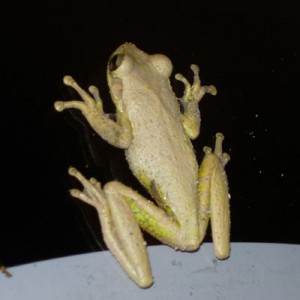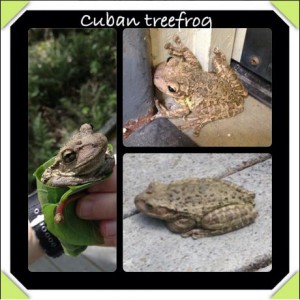Treefrog! Did you know the invasive Cuban treefrog can grow to be 5.5 inches? That is quite big considering the largest of our native treefrogs only grows to be 2.5 inches. It’s also a good way to help identify this invasive species.
Many of you have probably heard this at night either right around your home or in nearby woods. That is the sound of a Cuban treefrog, a sound often undesirable for those trying to fall asleep at night. The good news is you can save yourself a headache and save our native frogs by doing your part to help reduce the population of the Cuban treefrogs around your home.
But first, you need to know a little more about these jumpers…
Cuban treefrogs came from, you guessed it, Cuba. And their populations have spread throughout much of Florida. Their diet is similar to that of other frogs, eating beetles, roaches, spiders, and other insects, but they will also eat other frogs, lizards and even snakes! I have witnessed a Cuban treefrog eat a native treefrog twice now and it has only motivated me to help in the control of this invasive species even more. Why? The Cuban treefrogs are competing with our native treefrogs for food and space.
How To Identify A Cuban Treefrog:
- If size is not a distinguishing characteristic, take a look at the frog’s toepads. All treefrogs have toepads to help them climb, but Cuban treefrogs have very large toe pads when compared to native treefrogs.

Note the larger toepads of the invasive Cuban treefrog. Line drawing by Monica E. McGarrity (UF)
- They also tend to have large bulging eyes

Note the bulging eyes and large toepads of the Cuban treefrog. Photos by Dr. Steve A. Johnson (UF), Ryan C. Means (Coastal Plains Institute), Esther Langan (Smithsonian’s National Zoo), and Diana Evans
- When young, Cuban treefrogs have reddish eyes, are olive-brown in color, have light stripes along their side, and they have blue bone that can best be seen through the skin on the underside of hind legs.



Photos by Dr. Steve A. Johnson (UF), Ryan C. Means (Coastal Plains Institute), Esther Langan (Smithsonian’s National Zoo), and Diana Evans
- Unfortunately color is not a reliable feature when it comes to identifying Cuban treefrogs. They can vary in color quite a bit, but they are most often a creamy white to light brown with bumpy skin.





Note the various colors of the different Cuban treefrogs. Photos by Dr. Steve A. Johnson (UF), Ryan C. Means (Coastal Plains Institute), Esther Langan (Smithsonian’s National Zoo), and Diana Evans
Cuban treefrogs can thrive in urban areas and are commonly found on and around homes and buildings, and in gardens and landscape plants.
How You Can Help:
You can help manage Cuban treefrogs around your home by capturing and humanely euthanizing (killing) them.
- After properly identifying the frog as a Cuban treefrog, you can capture it using gloves or a plastic bag to protect yourself from the irritating mucus on its skin.

Large Cuban treefrog found at Brooker Creek Preserve in Tarpon Springs, FL. Photos by Lara Milligan.
- Another way to catch the frogs is to place 1.5” PVC pipes in the ground around your home which can attract treefrogs. The frogs use the pipe as a source of shelter. Check the pipes regularly for effective management. Once you have a Cuban treefrog in the pipe, place a plastic sandwich bag over the top, pull the pipe out of the ground and use a broom handle or other “plunger” device in the other end to scare the frog into the sandwich bag. This is best done with two people. The sandwich bag should be held tightly around the pipe because as soon as the frog hits the bag it will most likely start jumping and try to get away. They are slippery too!

PVC pipes placed around a home to provide shelter for treefrogs and to help capture the invasive Cuban treefrog. Photo by Dr. Steve A. Johnson (UF)
- Once in the bag or captured by hand and placed in a bag, apply benzocaine ointment or spray on the frogs back and place in sealed bag for 15-20 minutes. Frogs breathe through their skin, so the benzocaine will be absorbed into their system and put them to sleep. Benzocaine is commonly used to treat sunburn, toothaches and sore throats and can be found at most convenience stores.
Note: If you are unable to apply benzocaine you can skip #3 and move on to #4.
- Place the sealed bag in the freezer overnight and dispose of the frog in bag the next day.
- Always wash your hands well after handling the frog.
- Help me reach more people with this information by sharing what you have learned with your neighbors, friends, and colleagues.
Thanks for doing your part to help keep Pinellas County free of invasive species! You can learn more about the Cuban treefrog at the links below.
Sources:
http://ufwildlife.ifas.ufl.edu/frogs/cubantreefrog.shtml
http://edis.ifas.ufl.edu/uw259
http://ufwildlife.ifas.ufl.edu/cuban_treefrog_inFL.shtml
https://www.youtube.com/watch?v=Hs1GRC5wJXc
 0
0












